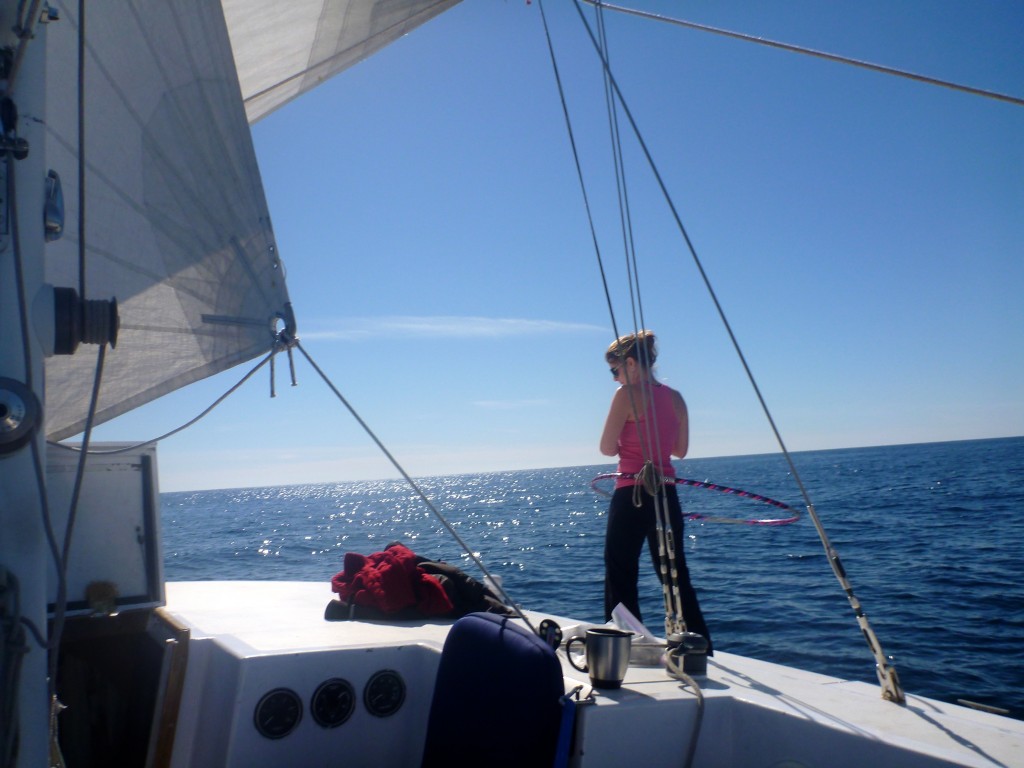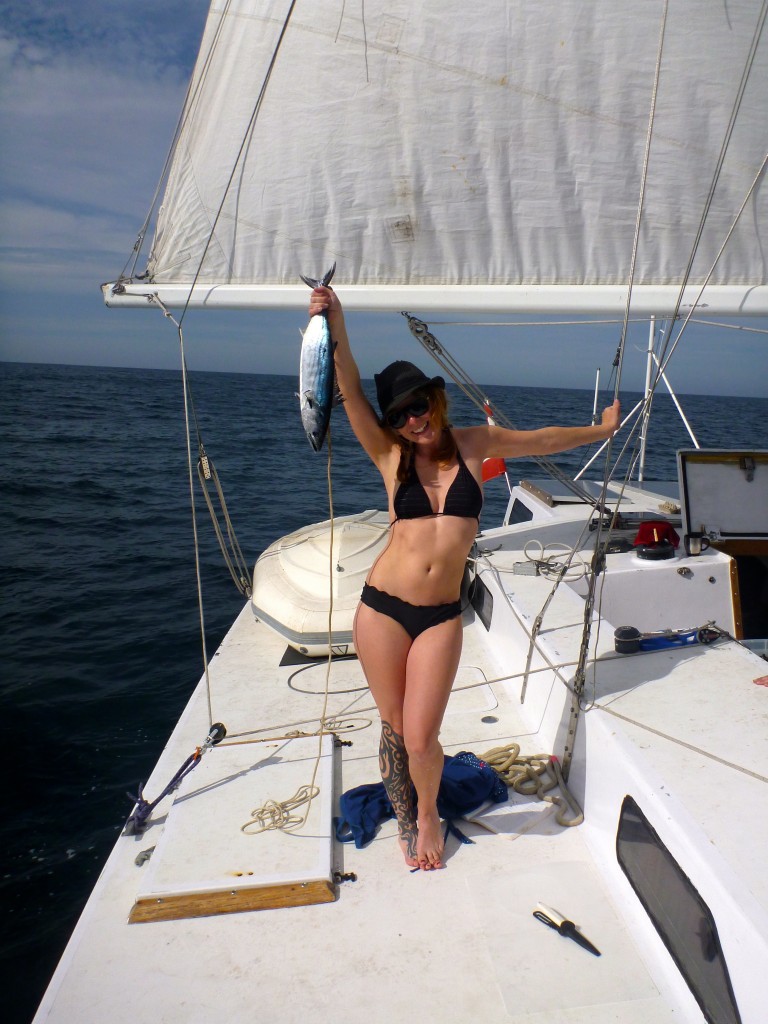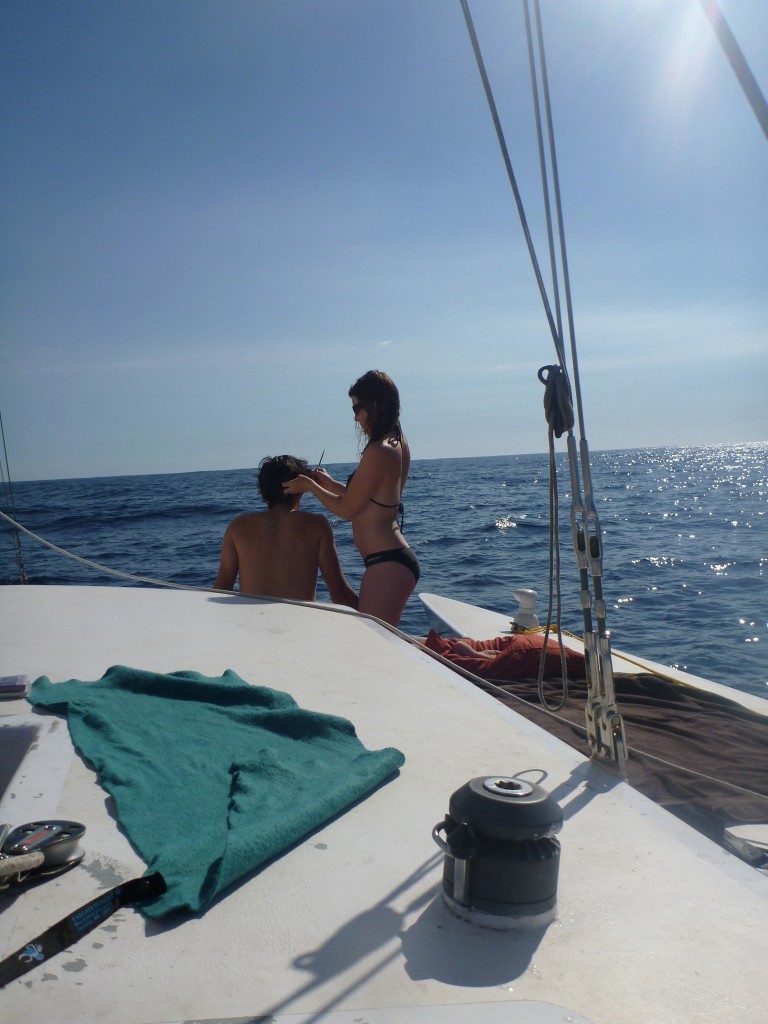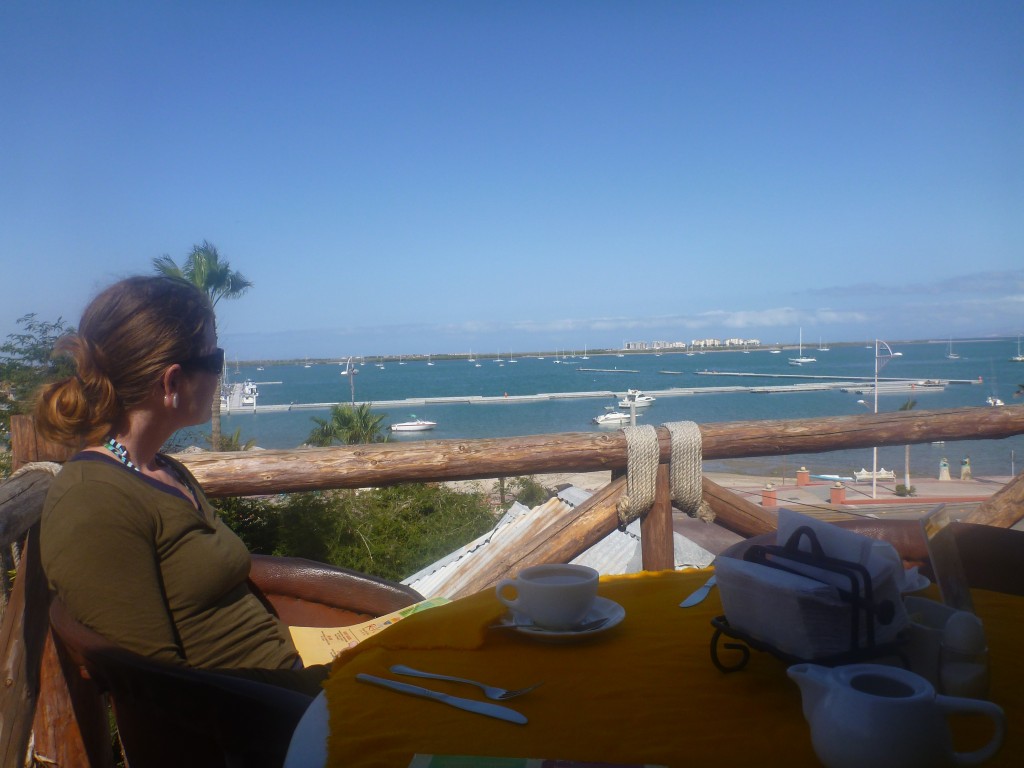Ok! Hopefully this will be the last big photo-dump update for a while and I’ll be able to get back on track with regular updates – but really, how many times have I said that before? I do take a great deal of pleasure in having this adventure online, but at some point the adventures have to be simply enjoyed without worrying too much about documentation.
On January 29th, a solid two days before we’d be legally in the doghouse with US Customs for overstaying our welcome in the United States (well, technically only I would be in trouble, Miya is American), we left San Diego harbour, turned left and headed for Ensenada.
On to the photos!

The yellow flag, flown at the top of the flag halyard on the starboard spreader, represents the letter ‘Q’, which, flown alone with no other signal flags, signifies ‘quarantine’. The quarantine flag is flown when crossing a border, to let the governing bodies know that the vessel has not yet cleared customs for that country but does intend to.

We left San Diego in the afternoon, and we figure we crossed the border just as the sun set. We had excellent weather and a beautiful moon for most of the trip down.

What a stark difference over sailing down the Oregon coast! The water was a startling sapphire blue and the mornings were warm and sunny.

Arriving in Ensenada late at night – apparently no matter how we plan our trip we seem to be completely unable to arrive at our destination during daylight hours – we followed the instructions of our guidebooks and anchored “inside the breakwater”. In the morning we discovered we were anchored near the navy base, so we quickly pulled anchor and headed further into the harbour to find the sailing docks, just past the cruise ship terminal.

Customs was a bit of an adventure, but with our careful organization of documents and rudimentary knowledge of spanish (and a great deal of help from the Downwind Marine Cruising Guide), we made it through in about three hours of standing in various lines.
The courtesy flag (in this case the Mexican flag) is a show of respect to the country that a yacht is visiting – it’s usually followed by personal colours, in this case an American flag because Miya is American, and then by club colours, in this case the almost-destroyed Bluewater Cruising Association burgee.

Miya set her lines every day – three lines, one per person on the boat, each of us having purchased a Mexican fishing license – and was finally successful in catching what was either a skipjack tuna or a bonita, we’re not entirely sure. It was delicious, if a little bit oily.
Within a day or so of this catch, we found ourselves looking down off the side of the boat at a five-foot mako shark! The shark swam up to the boat, turned on its side, looked up at us for a moment and then swam off again. When Miya pulled up her lines later, all three were missing their lures and her downrigger/diver thing had a few deep scratches where it had been attacked by something with sharp teeth!

Sailing settled into an easy rhythm, with everyone getting ample sleep and the weather (mostly) cooperating. Our main problem during the long sunny days was a lack of wind – we had to be satisfied with trundling along at 2-3 knots.
Let me say that again: we spent days at a time on our 1200km sailing trip travelling at approximately 5km per hour.
It quickly becomes obvious that sailing is for people who love sailing, not for people who are in a hurry to get somewhere!

After a time, we realized that we could optimize our downwind sailing by dropping the staysail, switching the headsail to the 150 genoa and “poling it out” to fly the main and headsail in a wing-on-wing configuration. Unfortunately, we do not have a spinnaker pole! We improvised with our boathook as seen in this photo, but the collapsible boathook pole kept… collapsing. Eventually we tried an oar instead, and it worked very well – though we’re shopping for a used spinnaker pole now, as a very large percentage of sailing in the trade winds is downwind sailing. In the photo you can also see us using a snatch block and the staysail sheet winch to pull the sail downward, giving us much better control over trim.

This photo represents an adventure! Miya heard about the Laguna Ojo de Liebre on the internet, and we made plans to visit the lagoon on our way south. We pulled into the large bay that houses the lagoon late one night, and shortly after I got up for my midnight watch we encountered our first squall of the voyage, with winds gusting to… oh, I have no idea, our wind instruments have never worked properly. Suffice to say we required a double reef in the main, and we were still doing eight knots under just the main and staysail.
The squall was a northerly, and the lagoon was to the south – when we went to enter the long, shallow mouth of the lagoon we found ourselves swiftly approaching sand dunes, surfing down steep three-meter breaking waves. We broke our all-time speed record, hitting 15kn, before realizing that if one of those waves were to cause us to dig an ama bow into the sand the entire trip would come to an abrupt end. We quickly turned around and headed back out into the open bay.
In that bay, we saw something floating off in the distance, and I was curious so I took us on a fifteen-minute detour out to find out what that something was. It turned out to be a dead, bloated grey whale, which Miya found endlessly fascinating. The whale was blowing a steady stream of some sort of decay-gas from its mouth, and as it bobbed up and down in the small waves the gasses would alternately hiss into the air and bubble into the ocean.

Once back out into the open ocean, the water took on that unreal deep sapphire blue hue again, and we all took advantage of the warm, clear water to jump in with a handful of shampoo and get ourselves clean. With a pair of swim fins, it’s surprisingly easy to keep up with a sailboat travelling at about 2kn, even with both hands occupied with shampoo.

By this time it was almost three months since my last haircut, so we figured it was time to let Miya have a go at it. She’s performed probably thirty haircuts before, so I wasn’t that worried – and besides, even if it was botched utterly it would just be an excuse to give myself a nice, easy-to-maintain buzz cut.
She did a fine job – arguably one of my best haircuts of the past few years.

Just after breakfast one morning, Miya called me up on deck excitedly – a sea turtle was swimming along behind the boat, apparently following the thick white fishing lines. The turtle came closer and closer to the boat, eventually seeming to play in the slipstream of the main hull – it stayed with us for probably an hour, coming close enough for us to look it in the eyes and have a lovely conversation about fishing. Miya named her ‘Marguerite’.
I took a video of the turtle, and Miya posted it to her YouTube account.

Finally, as we rounded the tip of the Baja Peninsula, we saw some reasonable winds! We estimated around 20kn, and rather than start putting in reefs and taking down the headsail, we decided that it would be nice to “open her up a little”, and we spent most of the afternoon flying past Cabo at between 7.5 and 9.5 knots, splashing through whitecaps in the Mexican sunshine.

After rounding the peninsula, we had about 12h of good winds to ride north to La Paz – but then the winds shifted, and we spent the next day trying to beat our way northwest into northwesterly winds, gaining little ground. We were running low on fuel, so we couldn’t just motor the whole way – luckily we had time, so the next day or so we sailed to weather as best we could, with the winds taunting us, switching between “utterly dead” and “decent but in the exact opposite direction from what we’d like, regardless of our current tack”.
Finally, we had had enough – I looked at the fuel tank and decided that we had enough fuel to make it into La Paz by nightfall, and so we turned directly into the wind and motored for the next eight hours. The wind had been blowing steadily from that direction for at least a day, so the wind waves had built up quite a bit, and we were motoring right into them. We discovered at this point that if we harnessed ourselves in and went to stand at the absolute tip of the bow, the bow would dive down into the wave trough and then leap eight or nine feet straight up with the next wave! We all had a few turns; it was a fun diversion for an otherwise gruelling day.

The closer we got to land, the more Mexico started to show up in the boat. This was a giant moth that was found sleeping in the sink drain the last morning before arriving in La Paz. It was huge!

On the long trip down from San Diego, Miya’s garden began to thrive! Her carrots, broccoli, spinach and lettuce all sprouted, and the chives and parsley came up soon after. Combine all of those with her regular sprouting of a ‘salad mix’ of sprouting seeds, a 2kg bag of which she found on the internet, and her new sprout-in-a-towel technique for her micro greens, and we’ve got a very solid influx of green leafy things in our diet.

Finally we arrived in La Paz – we anchored out near the ‘Magote’, which as far as we can tell means “sand bar” (upon which someone decided it a wise choice to build timeshare condominiums; the mind boggles). The air is warm, the water is blue, and we’re settling in for a month or so while we get used to living in Mexico.
And that, my friends, brings me nearly up to date. The reality is that we’ve been here in La Paz for almost two weeks, and we’ve had a few adventures already, but at least I’m writing about the same country now. More to come, soon I hope, and with more regularity!




